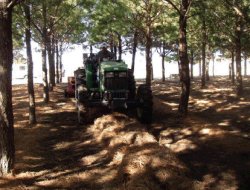AgEBB-MU CAFNR Extension
Green Horizons
Volume 20, Number 1
January 2016
Is a Pine Straw Industry in the Future for Missouri?
Growing Pine Straw
By Gene Garrett, Center for Agroforestry and Dusty Walker, MU Ag Extension Experiment Station
Pine straw (pine needles) is a natural product from pine trees that is used as a landscape or garden mulch in place of wood chips. While all pine trees shed their needles, all do not produce needles of sufficient length and quality (stiffness) to be baled and sold as pine straw. Minimal lengths of about 6 inches are required to bind a straw bale together.
 |
Missouri's only native pine, shortleaf pine (Pinus echinata), has needles that are 3 - 5 inches and too short to bale. Likewise, non-native species found growing in Missouri, like white pine (Pinus strobus), are soft-needled and lack the necessary needle characteristics. Of the pines available for a pine straw industry in Missouri, a pitch pine (P. rigida) X loblolly pine (P. taeda) hybrid is probably the best option. This hybrid looks and grows like loblolly pine but is cold tolerant like pitch pine (i.e., it does not show freeze damage in Missouri). In the southern part of Missouri, pure loblolly pine selections are available that will also perform well and produce the longer needles suited for pine straw.
Planting pine for pine straw production is no different from planting trees for any other purpose. Seedlings must be planted on a site that will accommodate their needs and a spacing selected that will support fast growth, heavy needle production, and harvesting of the pine straw.
A pitch x loblolly hybrid grows well on a variety of sites from flat poorly-drained ones to relatively dry, well-drained ones. However, it grows best on moist, moderately acid soils with imperfect to poor surface drainage and a fine-textured subsoil. Slope is also an important consideration and the flatter the site the easier it is to harvest. The planting can be designed to accommodate agroforestry practices, such as silvopasture and alley cropping, or consist of a square grid. Regardless of planting pattern, a minimum distance of about 12' between trees and rows is required to accommodate harvesting equipment. Weed control in the early years is also required to maximize seedling growth.
 |
With proper management, a pitch x loblolly planting will yield sufficient pine straw to justify the first commercial harvest at age 7. Pine straw is baled in late fall or early winter and is most commonly sold in 20 lb. bales. The expected yield, once the stand is established, should exceed 300 bales/acre. Commercial harvesting is accomplished by raking the pine straw into windrows and using a standard "in-line" baler and a small farm tractor. Wholesale prices vary, but The Center for Agroforestry received $5.50 per 20 lb. bale in 2015 for pine straw harvested from research plots. To have a healthy, productive pine straw program, healthy, vigorously growing trees must be maintained. To accomplish this, pine straw should be harvested every second or third year to help maintain organic matter and fertility levels. For every 100 bales of pine straw harvested, approximately 40 lbs. of nitrogen are lost. While fertilization needs will vary between sites, a good rule of thumb is to supplement with 150- 200 lbs. of nitrogen, 50 lbs. of elemental phosphorus, and 50 to 80 lbs. of potassium per acre, every 5 years. But remember, a valid prescription can only be made following a soil and foliar analysis.
While pine straw is a new forest product in Missouri, our state has vast acreages that would support pine straw plantings. With increased acres planted, current markets will expand and new markets will develop. There was a time, in the southeastern U. S., when pine straw was not available commercially and landowners hand-raked it for their strawberry plants to reduce weeds and conserve soil moisture. Today, in Georgia alone, pine straw is nearly a $100 million/year industry. The pitch x loblolly pine hybrid provides a unique opportunity for Missouri to also become a pine straw producing state. For additional information contact the Center for Agroforestry, Forestry Department, University of Missouri, Columbia, MO 65211.
